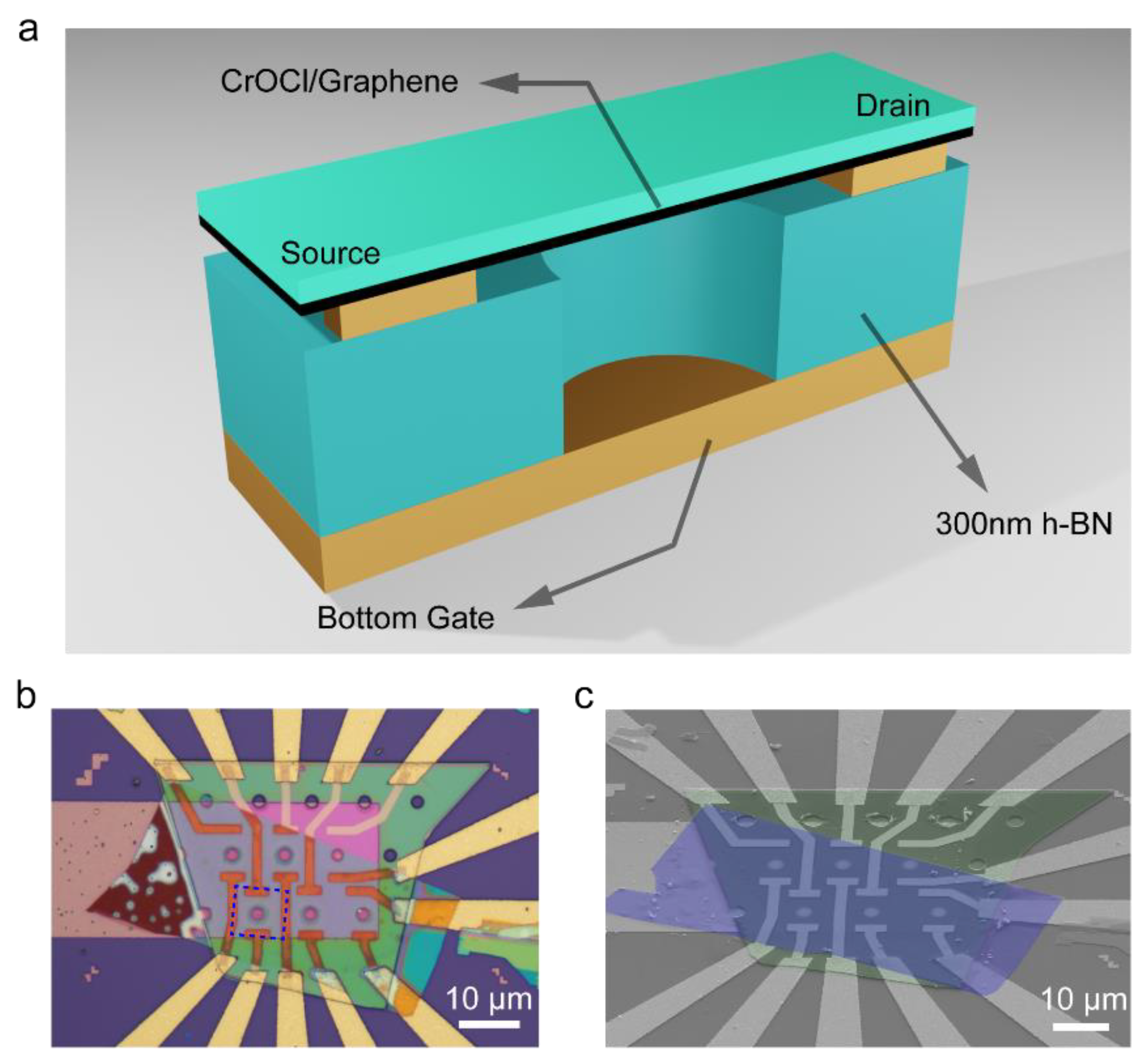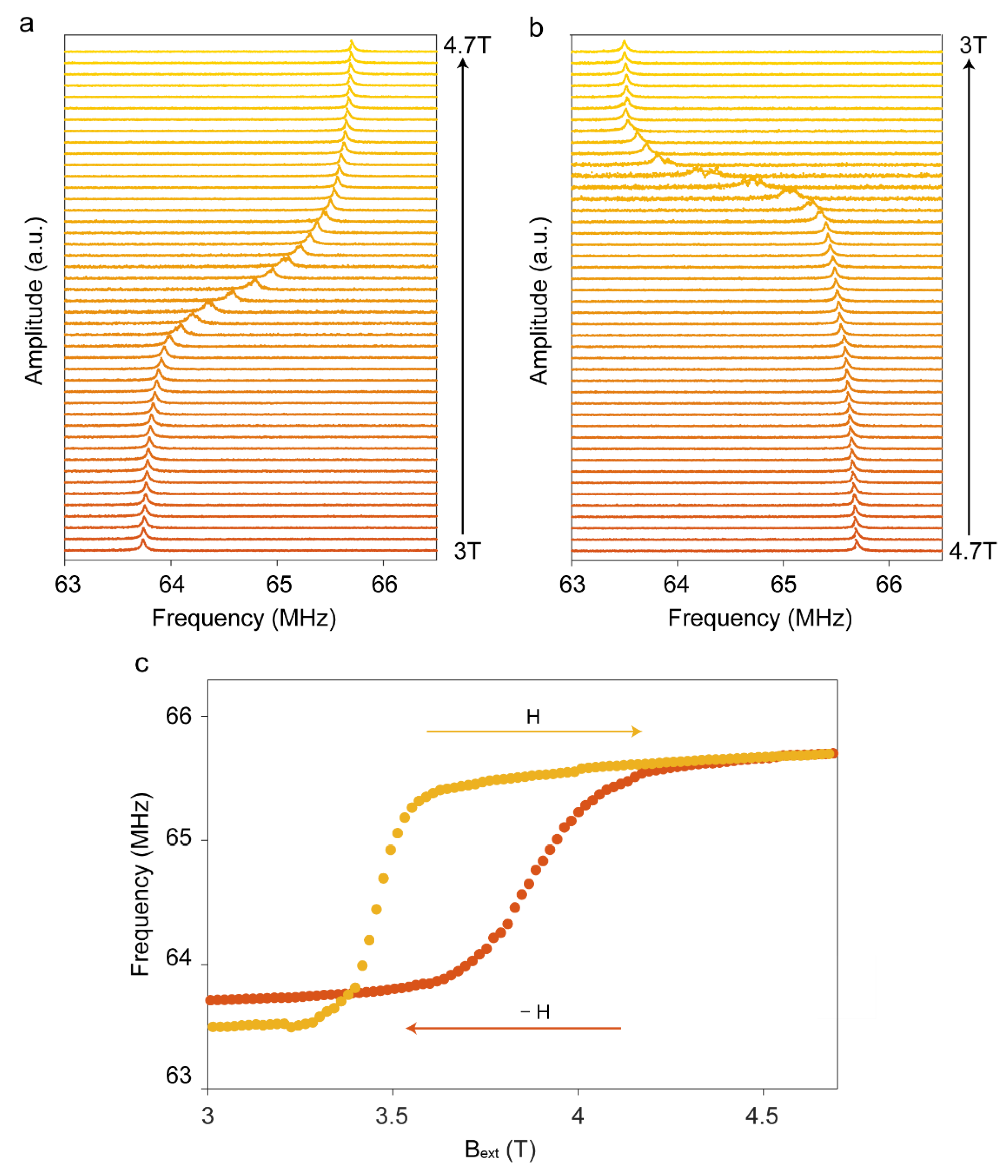Mechanical Detection of Magnetic Phase Transition in Suspended CrOCl Heterostructures
Abstract
1. Introduction
2. Materials and Fabrications
3. Results and Discussion
4. Conclusions
Author Contributions
Funding
Institutional Review Board Statement
Informed Consent Statement
Data Availability Statement
Acknowledgments
Conflicts of Interest
References
- Huang, B.; Clark, G.; Navarro-Moratalla, E.; Klein, D.R.; Cheng, R.; Seyler, K.L.; Zhong, D.; Schmidgall, E.; McGuire, M.A.; Cobden, D.H.; et al. Layer-dependent ferromagnetism in a van der Waals crystal down to the monolayer limit. Nature 2017, 546, 270–273. [Google Scholar] [CrossRef] [PubMed]
- Deng, Y.; Yu, Y.; Song, Y.; Zhang, J.; Wang, N.Z.; Sun, Z.; Yi, Y.; Wu, Y.Z.; Wu, S.; Zhu, J.; et al. Gate-tunable room-temperature ferromagnetism in two-dimensional Fe3GeTe2. Nature 2018, 563, 94–99. [Google Scholar] [CrossRef] [PubMed]
- Wang, X.; Tang, J.; Xia, X.; He, C.; Zhang, J.; Liu, Y.; Wan, C.; Fang, C.; Guo, C.; Yang, W.; et al. Current-driven magnetization switching in a van der Waals ferromagnet Fe3GeTe2. Sci. Adv. 2019, 5, eaaw8904. [Google Scholar] [CrossRef]
- Gong, C.; Li, L.; Li, Z.; Ji, H.; Stern, A.; Xia, Y.; Cao, T.; Bao, W.; Wang, C.; Wang, Y.; et al. Discovery of intrinsic ferromagnetism in two-dimensional van der Waals crystals. Nature 2017, 546, 265–269. [Google Scholar] [CrossRef] [PubMed]
- Wang, Z.; Zhang, T.; Ding, M.; Dong, B.; Li, Y.; Chen, M.; Li, X.; Huang, J.; Wang, H.; Zhao, X.; et al. Electric-field control of magnetism in a few-layered van der Waals ferromagnetic semiconductor. Nat. Nanotechnol. 2018, 13, 554–559. [Google Scholar] [CrossRef] [PubMed]
- Li, X.; Dong, B.; Sun, X.; Wang, H.; Yang, T.; Yu, G.; Han, Z.V. Perspectives on exfoliated two-dimensional spintronics. J. Semicond. 2019, 40, 081508. [Google Scholar] [CrossRef]
- Niu, J.; Yan, B.; Ji, Q.; Liu, Z.; Li, M.; Gao, P.; Zhang, Y.; Yu, D.; Wu, X. Anomalous Hall effect and magnetic orderings in nanothick V5S8. Phys. Rev. B 2017, 96, 075402. [Google Scholar] [CrossRef]
- Gong, C.; Zhang, X. Two-dimensional magnetic crystals and emergent heterostructure devices. Science 2019, 363, 706. [Google Scholar] [CrossRef] [PubMed]
- Song, T.; Sun, Q.; Anderson, E.; Wang, C.; Qian, J.; Taniguchi, T.; Watanabe, K.; McGuire, M.A.; Stöhr, R.; Xiao, D.; et al. Direct visualization of magnetic domains and moiré magnetism in twisted 2D magnets. Science 2021, 374, 1140–1144. [Google Scholar] [CrossRef]
- Telford, E.J.; Dismukes, A.H.; Lee, K.; Cheng, M.; Wieteska, A.; Bartholomew, A.K.; Chen, Y.; Xu, X.; Pasupathy, A.N.; Zhu, X.; et al. Layered Antiferromagnetism Induces Large Negative Magnetoresistance in the van Der Waals Semiconductor CrSBr. Adv. Mater. 2020, 32, 2003240. [Google Scholar] [CrossRef] [PubMed]
- Christensen, A.; Johansson, N.T.; Quezel, S. Preparation and Magnetic Properties of CrOCl. Acta Chem. Scand. A 1975, 28, 1171–1174. [Google Scholar] [CrossRef]
- Angelkort, J.; Wölfel, A.; Schönleber, A.; van Smaalen, S. Observation of strong magnetoelastic coupling in a first-order phase transition of CrOCl. Phys. Rev. B 2019, 80, 144416. [Google Scholar] [CrossRef]
- Miao, N.; Xu, B.; Zhu, L.; Zhou, J.; Sun, Z. 2D Intrinsic Ferromagnets from van der Waals Antiferromagnets. J. Am. Chem. Soc. 2018, 140, 2417–2420. [Google Scholar] [CrossRef]
- Bykov, M.; Bykova, E.; Dubrovinsky, L.; Hanfland, M.; Liermann, H.; van Smaalen, S. Pressure-induced normal-incommensurate and incommensurate- commensurate phase transitions in CrOCl. Sci. Rep. 2015, 5, 9647. [Google Scholar] [CrossRef] [PubMed]
- Liu, W.; Guo, X.; Schwartz, J.; Xie, H.; Dhale, N.U.; Sung, S.H.; Kondusamy, A.L.N.; Wang, X.; Zhao, H.; Berman, D.; et al. A three-stage magnetic phase transition revealed in ultrahigh-quality van der Waals bulk magnet CrSBr. ACS Nano 2022, 16, 15917–15926. [Google Scholar] [CrossRef]
- Zhang, T.; Wang, Y.; Li, H.; Zhong, F.; Shi, J.; Wu, M.; Sun, Z.; Shen, W.; Wei, B.; Hu, W.; et al. Magnetism and Optical Anisotropy in van der Waals Antiferromagnetic Insulator CrOCl. ACS Nano 2019, 13, 11353–11362. [Google Scholar] [CrossRef]
- Gu, P.; Sun, Y.; Wang, C.; Peng, Y.; Zhu, Y.; Cheng, X.; Yuan, K.; Lyu, C.; Liu, X.; Tan, Q.; et al. Magnetic Phase Transitions and Magnetoelastic Coupling in a Two-Dimensional Stripy Antiferromagnet. Nano Lett. 2022, 22, 1233–1241. [Google Scholar] [CrossRef] [PubMed]
- Qing, X.; Li, H.; Zhong, C.; Zhou, P.; Dong, Z.; Liu, J. Magnetism and spin exchange coupling in strained monolayer CrOCl. Phys. Chem. Chem. Phys. 2020, 22, 17255–17262. [Google Scholar] [CrossRef] [PubMed]
- Zheng, X.; Wei, Y.; Zhang, X.; Wei, Z.; Luo, W.; Guo, X.; Liu, J.; Peng, G.; Cai, W.; Huang, H.; et al. Symmetry Engineering Induced In-Plane Polarization in MoS2 through Van der Waals Interlayer Coupling. Adv. Funct. Mater. 2022, 32, 2202658. [Google Scholar] [CrossRef]
- Wang, Y.; Gao, X.; Yang, K.; Gu, P.; Dong, B.; Jiang, Y.; Watanabe, K.; Taniguchi, T.; Kang, J.; Lou, W.; et al. Flavoured quantum Hall phase in graphene/CrOCl heterostructures. Nat. Nanotechnol. 2022. [Google Scholar] [CrossRef]
- Yang, K.; Gao, X.; Wang, Y.; Zhang, T.; Gu, P.; Luo, Z.; Zheng, R.; Cao, S.; Wang, H.; Sun, X.; et al. Realization of graphene logics in an exciton-enhanced insulating phase. arXiv 2021. [Google Scholar] [CrossRef]
- Jiang, S.; Xie, H.; Shan, J.; Mak, K.F. Exchange magnetostriction in two-dimensional antiferromagnets. Nat. Mater. 2022, 19, 1295–1299. [Google Scholar] [CrossRef] [PubMed]
- Zhang, T.; Wang, H.; Xia, X.; Yan, N.; Sha, X.; Huang, J.; Watanabe, K.; Taniguchi, T.; Zhu, M.; Wang, L.; et al. A monolithically sculpted van der Waals nano-opto-electro-mechanical coupler. Light Sci. Appl. 2022, 11, 48. [Google Scholar] [CrossRef] [PubMed]
- Šiškins, M.; Lee, M.; Mañas-Valero, S.; Coronado, E.; Blanter, Y.M.; van der Zant, H.S.J.; Steeneken, P.G. Magnetic and electronic phase transitions probed by nanomechanical resonators. Nat. Commun. 2020, 11, 2698. [Google Scholar] [CrossRef] [PubMed]
- Šiškins, M.; Sokolovskaya, E.; Lee, M.; Mañas-Valero, S.; Davidovikj, D.; van der Zant, H.S.J.; Steeneken, P.G. Tunable strong coupling of mechanical resonance between spatially separated FePS3 nanodrums. Nano Lett. 2022, 22, 36–42. [Google Scholar] [CrossRef]
- Lee, M.; Šiškins, M.; Mañas-Valero, S.; Coronado, E.; Steeneken, P.G.; van der Zant, H.S.J. Study of charge density waves in suspended 2H-TaS2 and 2H-TaSe2 by nanomechanical resonance. Appl. Phys. Lett. 2021, 118, 193105. [Google Scholar] [CrossRef]
- Šiškins, M.; Kurdi, S.; Lee, M.; Slotboom, B.J.M.; Xing, W.; Mañas-Valero, S.; Coronado, E.; Jia, S.; Han, W.; van der Sar, T.; et al. Nanomechanical probing and strain tuning of the Curie temperature in suspended Cr2Ge2Te6 heterostructures. npj 2D Mater. Appl. 2022, 6, 41. [Google Scholar] [CrossRef]
- Castellanos-Gomez, A.; Buscema, M.; Molenaar, R.; Singh, V.; Janssen, L.; van der Zant, H.S.J.; Steele, G.A. Deterministic transfer of two-dimensional materials by all-dry viscoelastic stamping. 2D Mater. 2014, 1, 011002. [Google Scholar] [CrossRef]
- Lee, C.; Wei, X.; Kysar, J.W.; Hone, J. Measurement of the elastic properties and intrinsic strength of monolayer graphene. Science 2008, 321, 385–388. [Google Scholar] [CrossRef] [PubMed]
- Soler-Crespo, R.A.; Mao, L.; Wen, J.; Nguyen, H.T.; Zhang, X.; Wei, X.; Huang, J.; Nguyen, S.T.; Espinosa, H.D. Atomically thin polymer layer enhances toughness of graphene oxide monolayers. Matter 2019, 1, 369–388. [Google Scholar] [CrossRef]
- Wei, X.; Mao, L.; Soler-Crespo, R.A.; Paci, J.T.; Huang, J.; Nguyen, S.T.; Espinosa, H.D. Plasticity and ductility in graphene oxide through a mechanochemically induced damage tolerance mechanism. Nat. Commun. 2015, 6, 8029. [Google Scholar] [CrossRef] [PubMed]
- Sazonova, V.S. A Tunable Carbon Nanotube Resonator. Ph.D. Thesis, Cornell University, Ithaca, NY, USA, 2006. [Google Scholar]
- Chen, C. Graphene NanoElectroMechanical Resonators and Oscillators. Ph.D. Thesis, Cornell University, Ithaca, NY, USA, 2013. [Google Scholar]
- Jiang, J.; Wang, J.; Li, B. Young’s modulus of graphene: A molecular dynamics study. Phys. Rev. B 2009, 80, 113405. [Google Scholar] [CrossRef]




Publisher’s Note: MDPI stays neutral with regard to jurisdictional claims in published maps and institutional affiliations. |
© 2022 by the authors. Licensee MDPI, Basel, Switzerland. This article is an open access article distributed under the terms and conditions of the Creative Commons Attribution (CC BY) license (https://creativecommons.org/licenses/by/4.0/).
Share and Cite
Li, X.; Sha, X.; Yan, N.; Zhang, T. Mechanical Detection of Magnetic Phase Transition in Suspended CrOCl Heterostructures. Magnetochemistry 2022, 8, 170. https://doi.org/10.3390/magnetochemistry8120170
Li X, Sha X, Yan N, Zhang T. Mechanical Detection of Magnetic Phase Transition in Suspended CrOCl Heterostructures. Magnetochemistry. 2022; 8(12):170. https://doi.org/10.3390/magnetochemistry8120170
Chicago/Turabian StyleLi, Xiaoxi, Xuanzhe Sha, Ning Yan, and Tongyao Zhang. 2022. "Mechanical Detection of Magnetic Phase Transition in Suspended CrOCl Heterostructures" Magnetochemistry 8, no. 12: 170. https://doi.org/10.3390/magnetochemistry8120170
APA StyleLi, X., Sha, X., Yan, N., & Zhang, T. (2022). Mechanical Detection of Magnetic Phase Transition in Suspended CrOCl Heterostructures. Magnetochemistry, 8(12), 170. https://doi.org/10.3390/magnetochemistry8120170







